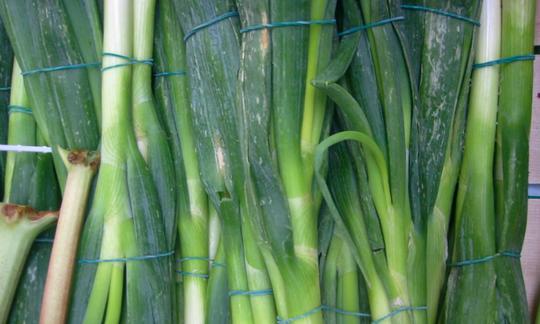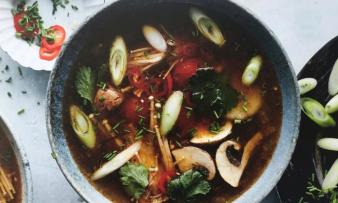Table of contents
Spring onions ( Allium fistulosum ) are also known as scallions or green onions. The stems and leaves taste similar to chives when eaten raw and are rich in vitamin K.
Use in the kitchen
With spring onions you can eat the whole plant raw, that is, both the green part and the spring onion base.
The green stalks (or stalks = leaves) have an intense, leek-like and slightly spicy taste. They can be used like chives ( Allium schoenoprasum ). The whole spring onion also has the white base, which is shorter or longer depending on the variety and can also be a little thicker at the bottom (cylindrical to slightly rounded thickening). 1 This part does not form a clear bulb; nevertheless, in everyday language it is sometimes referred to as a "spring onion bulb". It is white and tastes very tender and mild. It is also much less spicy than the bulbs of white or red onions ( Allium cepa ) and shallots .
Spring or winter onions do not need to be peeled. Simply rinse them well with water to ensure that no dirt or soil remains. Your eyes will hardly start to water when you cut them.
The leaves are suitable raw for salads or soups, as a topping on bread, for spreads, dips and sauces. In Asian cuisine, the green part of the spring onion is also particularly popular in cooked dishes. However, you should be careful not to fry or cook the leaves too hot, otherwise they will lose their aroma.
Depending on the use, there are different cutting techniques. Long strips are ideal for soups and salads. Diagonally cut, the 2-3 cm pieces can be prepared in a pan with other vegetables, tofu , etc. Chopped up, they go well with wholegrain rice or quinoa - also as a substitute for onions, leeks or chives .
Are spring onion flowers edible? The white flowers are edible. They taste subtly of onions and are suitable as a garnish for salads and other vegan dishes.
You can also use the seeds of spring onions. You can store them dried in a spice grinder and sprinkle them over the dish just before eating. However, as their aroma is very volatile, they must be stored away from light.
Vegan recipe for spring onion risotto
Ingredients (for 4 servings): 12 raw spring onions (organic), 2 tbsp vegetable margarine , 300 g risotto rice , 800 ml vegetable stock , yeast flakes (or almond parmesan ) as topping, salt andpepper .
Preparation: Cut off the spring onion greens, chop roughly and set aside. Finely chop the spring onion bulbs and sauté in a pan with margarine. Add the rice and sauté until translucent. Pour in half of the stock and simmer for about 15 minutes, stirring. If you use wholegrain rice , you will need about 45-60 minutes of cooking time. Gradually add the remaining liquid. Add the chopped spring onion greens to the risotto and season with salt and pepper. Sprinkle the vegan dish with yeast flakes before serving.
Vegan recipes with spring onions (stems and leaves) can be found under the note: " Recipes that have the most of this ingredient ".
| Not only vegans or vegetarians should read this: Vegans often eat unhealthily. Avoidable nutritional mistakes . |
Purchasing - Storage
At supermarket chains such as Coop , Migros , Denner , Volg , Spar , Aldi , Lidl , Rewe , Edeka , Hofer , Billa etc. and in organic supermarkets ( Denn's Biomarkt , Alnatura ) you can buy whole spring onions or spring onions in bunches almost all year round . If you want real spring onions, make sure that the vegetable has not developed a distinct bulb. 1,2 Make sure that when you buy them, all the green parts are still plump and that the tubes do not have any open cut surfaces.
Fresh stems or leaves cannot be found separately in the supermarket. However, it is possible to buy the green parts as a dried organic product. This is usually no longer considered raw food. 19,20
Found in the wild
The so-called winter onion does not grow wild in Germany. Wild ancestors of the species Allium fistulosum can be found in Siberia, including at Lake Baikal 3 (this is A. altaicum 1 ).
Storage tips
How do you store spring onions? It's best to keep them in the fridge and use them quickly. How long do spring onions last? The shelf life of spring onions is very limited. The whole plant lasts 2-3 days in the vegetable drawer, the bulbs last a little longer without leaves. Wrapped in foil, they stay fresh for a few days longer, even with the green tubes. The green stalks only last 1-2 days in the fridge when stored separately.
When are spring onions bad? If the bulbs start to weaken, you should no longer eat them. They lose their aroma and no longer taste good. After about a week, the bulb can also become woody and the good taste disappears.
Can you freeze spring onions? Yes, you can freeze raw spring onions. To do this, wash the spring onions, drain them and cut them into rings or roughly chop them. It is important to dry them well after washing, as too much water can cause freezer burn: these are dried-out outer layers. To prevent the onion pieces from freezing as lumps, you should spread the cut onions loosely on a plate lined with baking paper and freeze for a few hours. Take the plate out of the freezer, carefully remove the onions from the baking paper and transfer them to a plastic bag or a suitable container. Put them back in the freezer immediately so that the pieces do not thaw. After thawing, the onion pieces are hardly suitable as raw food, but their quality is sufficient for cooked dishes.
Ingredients - Nutritional values - Calories
The green part of the spring onion (upper plant organs) is very tasty and easy to digest. The calorie content is 27 kcal/100g. Leaves and stems consist of 92% water and contain 1.8 grams of fiber, 5.7 grams of carbohydrates and a small amount of protein and fat per 100 g. 4
The leafy greens contain 156 µg of vitamin K per 100 g, which is twice the daily requirement. For comparison: Swiss chard contains 830 µg, Brussels sprouts 177 µg and leeks 47 µg per 100 g. 4 Vitamin K is mainly found in green vegetables. To avoid excessive vitamin loss, these varieties should always be stored in the dark. The vitamin is relatively heat-stable, but not light-stable.
The stems and leaves of spring onions also provide folic acid : 30 µg/100g is not particularly much when compared to a daily requirement of around 300 µg 6 , but should not be underestimated when consumed regularly. Oranges and lemon balm have the same values, while rocket has significantly more at 97 µg/100g. 4
Potassium is just about worth mentioning as a mineral in onions. 100 g of the greens provide 159 mg of potassium, which is not nearly enough to cover the recommended daily requirement of 4 g, but 21 is not bad for a vegetable. The "potassium-rich" banana, in comparison, contains 360 mg of potassium. Spices and dried herbs contain particularly high levels of potassium: turmeric, for example, contains 2080 mg/100g, cumin seeds 1788 mg and dried coriander leaves even 4466 mg. Pulses contain between 1000 and 1800 mg. 4
The total ingredients of raw spring onions (stems and leaves), the coverage of the daily requirement and comparison values with other ingredients can be found in our nutrient tables. In the article Nutrients explained you will get a detailed insight into the topic.
Health effects
How healthy are spring onions? The health aspect of the stems and leaves is high; the ingredients are roughly comparable to whole spring onions and kitchen onions.
The vitamin K in the green part of spring onions is important for proper blood clotting and is involved in bone formation. Vitamin K is also given to newborns to replenish their reserves.
The polyphenols (flavonoids) contained in the leaves and the entire plant improve blood circulation and prevent blood clots and arteriosclerosis. The potential for anti-arthritis mechanisms is also being researched. 5,7
Onions of all kinds help with bronchial and asthmatic diseases. They are said to have antibiotic, heart and vascular protective, diuretic and anti-cancer properties. 5 You can find more details about the positive effects of onions on the human body under the ingredient onion, raw .
Dangers - Intolerances - Side effects
Although most onions are poisonous or indigestible for humans, both kitchen onions and spring onions are important for maintaining our health. They can be poisonous for other mammals (eg dogs, cats and horses).
Some allergy sufferers may develop contact eczema, in which - as with garlic - low-molecular sulphur compounds act as allergens. Onions contain other proteins that can trigger allergies: lipid transfer protein (All c 3), profilin (All c 4, cross-allergen with grass pollen) and alliin lyase (cross-allergen with other types of allium). 11
Ecological footprint - animal welfare
When studying the ecological balance, no distinction is often made between the individual types of onion.
In 2019, the Institute for Energy and Environmental Research Heidelberg ( ifeu ) examined almost 200 foods in Germany for their environmental impact. The calculation of the ecological footprint is based on average values for agricultural production (including all upstream processes, such as fertilizer production), food processing, packaging (including disposal of the same) and distribution to the supermarket. Different cultivation methods (organic - conventional), domestic production vs. import by truck, ship or plane, etc. were also taken into account. For selected foods, the authors also point out the phosphate, water and land consumption. Onions generally have a good CO 2 footprint at 0.2 kg CO 2 eq/kg, 13 provided they come from regional production.
Another positive aspect for the environmental impact of onions is the possibility of outdoor cultivation in the DA-CH region almost all year round if suitable varieties are chosen. 15 The amount of water required to produce 1 kg of onions is on average 272 litres. 14
Leeks and spring onions in particular can contain residues of pesticides. 16 Ideally, you should therefore buy organically grown vegetables, as the use of such products is prohibited.
Worldwide distribution - cultivation
Researchers assume that spring onions ( Allium fistulosum ) were domesticated near Lake Baikal (in Siberia, near the Altai Mountains in Russia) and in the west or northwest of China. 1 In China, this species was used 2000 years before the common era. 8 During the Middle Ages, it came to Europe via Russia. 1
Since the kitchen onion ( Allium cepa ) does not thrive so well in tropical climates, spring onions or winter onions are preferred there. In Asia, they are often grown after rice. 9 In Switzerland, after the Second World War, it was common to grow winter onions after potatoes. In the home garden, they are best grown after peas or beans , so they have a nitrogen-rich pre-crop.
According to FAOSTAT, 4.56 million tons of green onions and shallots were produced worldwide in 2021. The main producing countries are the People's Republic of China (869,838 tons), Mali (684,653 tons), Japan (512,933 tons) and South Korea (424,456 tons). 12
Fungal pathogens can cause problems: Downy mildew ( Peronospora destructor ) is very common in onion plants and can lead to significant crop failures. Organic farmers also have to contend with high weed pressure when growing onions without pesticides. For this reason, organic onions are significantly more expensive than those grown conventionally. 17
Growing in the garden
Spring onions are not very demanding. To ensure successful cultivation, they need a location in full sun. The soil must not be too heavy, because onions love loose, sandy and well-drained soil, otherwise they will start to rot. 10 Further details are described under the ingredient spring / leek / winter onions .
You can harvest the entire spring onion by carefully pulling it out of the ground. Or you can cut off the green parts and part of the stem, so that the plant can regenerate again and again and can be used as a permanent crop. You can even harvest spring onions in winter, as long as it is not too cold (depending on the type, the plant will then shrink 8 ). However, the cut parts of the plant do not last as long, as the cut surfaces dry out more quickly.
Further information
Spring onions or winter onions, Allium fistulosum (syn: Allium altaicum , A. ceratophyllum , Cepa sissilis and C. ventricosa ), belong to the subfamily of the allium family (Allioideae).
Possible confusion
The green parts of spring onions look very similar to the leaves of young onions. What are the differences between winter onions (spring onions, scallions) and young onions? If the vegetable has a bulb, it is not a spring onion or winter onion, 1,8 but a young onion (young onion). 2 However, the names are often not clear. Sometimes cooking onions ( Allium cepa ) that are planted in autumn are also called winter onions. This is probably because they are neither skin-tight nor easy to store - just like real winter or spring onions ( Allium fistulosum ). The Latin name is used to clearly distinguish them.
The shape of the whole spring onion is similar to the leek . What is the difference between leek and spring onion? Onions always have tubular leaves and leeks have broad, flat leaves that are layered on top of each other.
Alternative names
Common names such as early onion, young onion, spring onion, onion tube, onion tube, tube onion, scallion onion, scallion onion, chive onion, everlasting onion, winter hedge, winter hedge onion, white Florentine, coarse chive, scallop, St. John's garlic, meat leek, hollow leek or Schnattra are also common. The green leaves of a spring onion are often called scallions. Regionally used names are: dume Porrum, Fleisslauch, Hackezwiebel (Magdeburg), Jakobszwiebel (East Frisia), Johannislauch (East Frisia), Narr, Narren and Somzwiebel (Transylvania).
In English, these onions are known as Welsh onion, bunching onion, long green onion, Japanese bunching onion and spring onion. In the USA, in all mid-Atlantic coastal cities and in New England, they are called "scallion". In the rest of the USA, spring onions are called green onions, spring onions or salad onions. 18









Comments